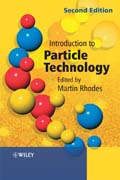
Introduction to Particle Technology , Second Edition provides a comprehensiveintroduction to the many concepts of this broad subject. Completely updated and revised, this new edition provides an excellent introduction to particle technology. Additional chapters have been added and case studies are provided alongside real-life industrial applications illustrating the techniques and theory. INDICE: 1.Particle Size Analysis 1.1Introduction 1.2 Describing The Size Of A Single Particle 1.3 Description Of Populations Of Particles 1.4 ConversionBetween Distributions 1.5 Describing The Population By A Single Number 1.6 Equivalence Of Means 1.7 Common Methods Of Displaying Size Distributions 1.8 Methods Of Particle Size Measurement 1.9 Sampling 1.10 Worked Examples Exercises 2. Single Particles in a Fluid 2.1 Motion Of Solid Particles In A Fluid 2.2 Particles Falling Under Gravity Through A Fluid 2.3 Non-Spherical Particles 2.4 Effect Of Boundaries On Terminal Velocity 2.5 Further Reading 2.6 Worked Examples Exercises 3. Multiple Particle Systems 3.1 Settling Of A Suspension Of Particles 3.2 Batch Settling 3.3 Continuous Settling 3.4 Worked Examples Exercises 4. Slurry Transport 4.1 Introduction 4.2 Flow Condition 4.3 Rheological Models For Homogeneous Slurries 4.4 Heterogeneous Slurries 4.5 Components Of A Slurry Flow System 4.6 Worked Examples 4.7 Further Reading Exercises References 5. Colloids and Fine Particles 5.1 Introduction 5.2 Brownian Motion 5.3 SurfaceForces 5.4 Result of Surface Forces on Behaviour in Air and Water. 5.5 Influences of Particle Size and Surface Forces on Solid/Liquid Separation by Sedimentation 5.6 Suspension Rheology 5.7 Influence of Surface Forces on Suspension Flow 5.8 Nanoparticles 5.9 Worked Examples Exercises References 6. Fluid Flow Through a Packed Bed of Particles 6.1 Pressure DropFlow Relationship 6.2 Filtration 6.3 Further Reading 6.4 Worked Examples Exercises 7. Fluidization 7.1 Fundamentals 7.2 Relevant Powder And Particle Properties 7.3 Bubbling And Non-Bubbling Fluidization 7.4 Classification Of Powders 7.5 Expansion Of A Fluidized Bed 7.6 Entrainment 7.7 Heat Transfer In Fluidized Beds 7.8 Applications Of Fluidized Beds 7.9 A Simple Model For The Bubbling Fluidized Bed Reactor 7.10 Some Practical Considerations 7.11 Worked Examples Exercises 8. Pneumatic transport and standpipes 8.1 Pneumatic Transport 8.2 Standpipes 8.3 Further Reading 8.4 Worked Examples Exercises 9. Separation of Particles 9.1 Gas Cyclones Description 9.2 Flow Characteristics 9.3 Efficiency Of Separation 9.4 Scale-Up Of Cyclones 9.5 Range Of Operation 9.6 Some Practical Design And Operation Details 9.7 Worked Examples Exercises 10. Storage and Flow of Powders Hopper Design 10.1 Introduction 10.2 Mass Flow And Core Flow 10.3 The Design Philosophy 10.4Shear Cell Tests 10.5 Analysis Of Shear Cell Test Results 10.6 Summary Of Design Procedure 10.7 Discharge Aids 10.8 Pressure On The Base Of A Tall Cylindrical Bin 10.9 Mass Flow Rates 10.10 Conclusions 10.11 Worked Examples Exercises11. Mixing and Segregation 11.1 Introduction 11.2 Types Of Mixture 11.3 Segregation 11.4 Reduction Of Segregation 11.5 Equipment For Particulate Mixing 11.6 Assessing The Mixture 11.7 Worked Examples Exercises 12. Particle Size Reduction 12.1 Introduction 12.2 Particle Fracture Mechanisms 12.3 Model PredictingEnergy Requirement And Product Size Distribution 12.4 Types Of Comminution Equipment 12.5 Worked Examples Exercises 13. Size Enlargement 13.1 Introduction 13.2 Interparticle Forces 13.3 Granulation 13.4 Worked Examples Exercises Notation 14. Health effects of fine powders 14.1 Introduction 14.2 The human respiratory system 14.3 Interaction of fine powders with the respiratory system 14.4 Pulmonary delivery of drugs 14.5 Harmful effects of fine powders References Exercises 15. Fire and Explosion Hazards of Fine Powders 15.1 Introduction 15.2 Combustion Fundamentals 15.3 Combustion In Dust Clouds 15.4 Control Of The Hazard 15.5 Worked Examples Exercises 16. Case Studies List of Symbols References Notation References Index
- ISBN: 978-0-470-01427-1
- Editorial: John Wiley & Sons
- Encuadernacion: Cartoné
- Páginas: 464
- Fecha Publicación: 14/03/2008
- Nº Volúmenes: 1
- Idioma: Inglés
